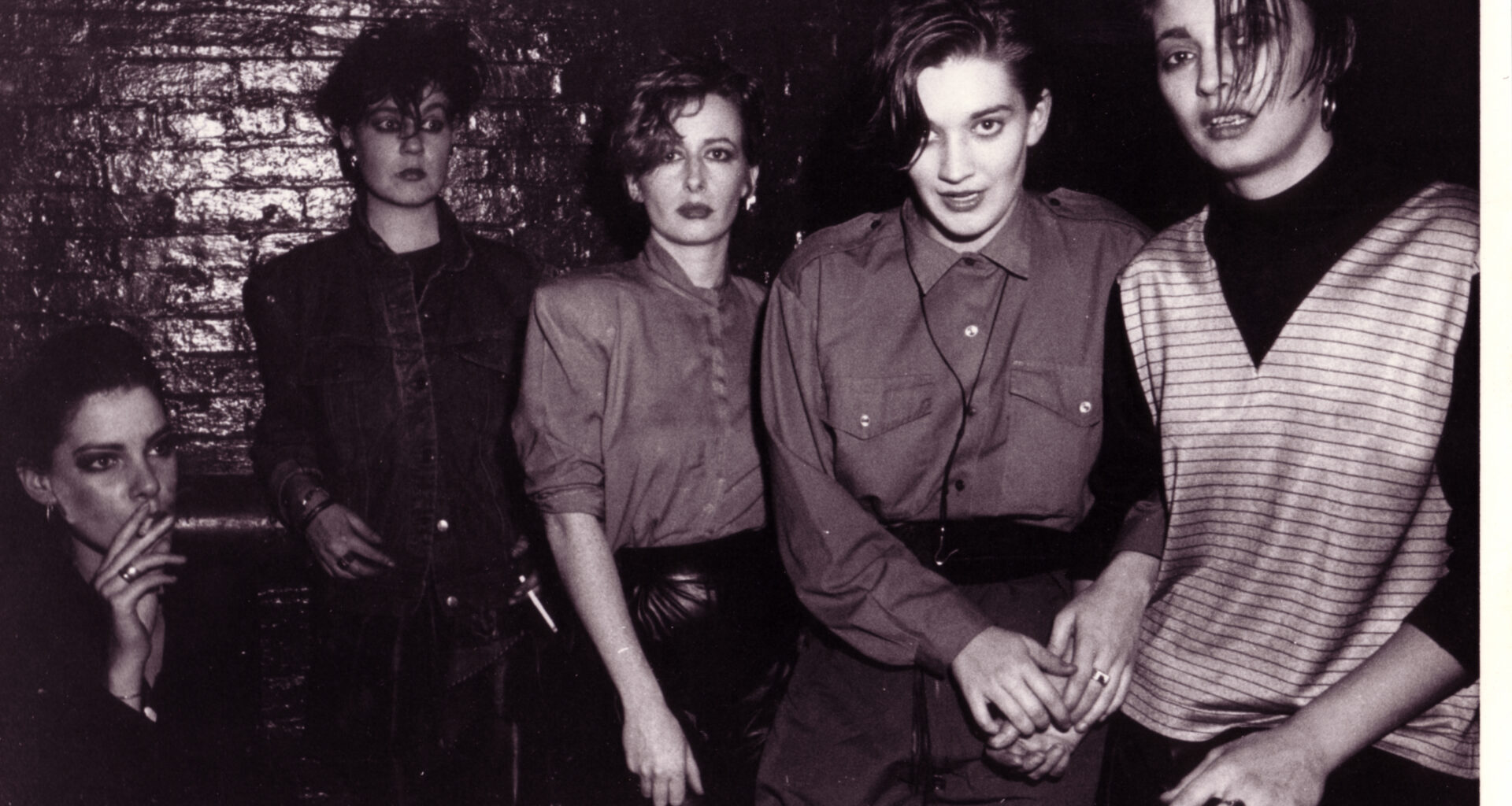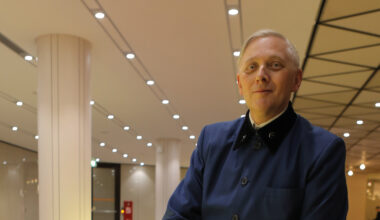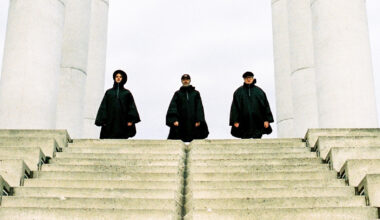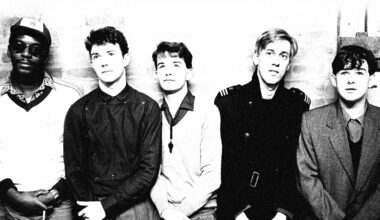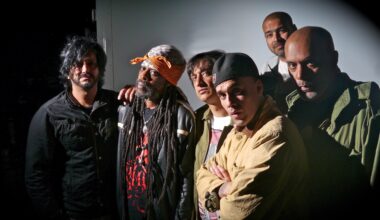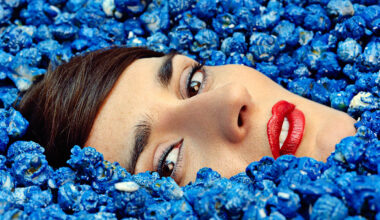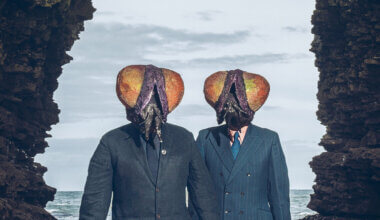Gudrun Gut moved to West Berlin in 1975 and she’s been there ever since. Initially enticed by the smell of kebabs wafting through the air, which represented freedom to her, Gudrun Bredemann hunkered down in the political enclave and artistic demi-monde, gradually becoming punk’s answer to Marlene Dietrich.
“The kebabs story is true,” she tells me with a chuckle. “I come from the heathlands in the north of Germany and people’s lives were really controlled and repressed in much of the country in those days. There was a lot of that, ‘Oh, what are the neighbours doing?’ kind of thing. I couldn’t breathe anymore. When I came to Berlin, I immediately thought, ‘Yes! I want to be here’.”
Gut’s loyalty to the city has been tested only once. She briefly considered moving to Spain when she felt the Berlin music scene was getting depressing towards the end of the 1980s, but then everything changed again.
“I was thinking of moving to Barcelona,” she admits. “The scene in Berlin wasn’t there the way that it had been. There was no support, the music was really dark and druggy, and there just wasn’t any energy left. But then the Wall came down and I just couldn’t go. It was too exciting after that.”
Gudrun Gut’s story is action-packed and not necessarily easy to follow, but let’s have a go. Not long after relocating, she hitch-hiked to London for a short stay and came back a punk – a first for West Berlin. Adopting the surname Gut was Blixa Bargeld’s idea. It came from “Gudrun ist gut” and was a nicely alliterative, non-ironic name at odds with the negative nomenclature that was in vogue in punk at the time (Johnny Rotten, Rat Scabies, etc).
Gut cut her hair short and wore colourful jumpsuits, a sign that she had imbued the spirit of punk rather than become a postcard facsimile. The elasticity of her interpretation would allow her to shape-shift and innovate through the post-punk era and then later within techno, a radical new form of music that was distrusted and derided by many of her peers.
From the late 70s onwards, Gut formed many bands, often all at the same time. DIN A Testbild, Mania D, Malaria! and Matador were followed by ‘Miasma’, an album with Myra Davies which was more of a performance art project. In 1997 came her ‘Members Of The Ocean Club’ album, a landmark in Gut’s career well worth exploring. It’s a vital and ageless series of dance collaborations with a revolving door of artists, including Blixa Bargeld, Danielle de Picciotto and Anita Lane.
Back in 1980, there was also a brief spell in Einstürzende Neubauten with Bargeld. I ask Gut if there was too much toxic masculinity within the band back then?
“No, it wasn’t like that at all at the beginning,” she protests. “We were 50-50 male and female at that time. Beate Bartel played bass and I played a Korg, and then there was Andrew [NU Unruh] and Blixa. So it was different then. It was very free, very experimental stuff. Beate and I only played for the first year because we had Mania D already happening and that was getting more and more important to us.”
There’s a beautiful video for the song ‘Die Sonne’ from the ‘Members Of The Ocean Club’ album featuring Gut and Bargeld in a series of mystical scenes. Made by Angela Conway, it’s a transcendental cyber-goth reunion between the two old friends and their exquisite cheekbones. Despite the evident camaraderie, I wonder why all of Gut’s bands after Einstürzende Neubauten were female-only.
“It was clear that Neubauten was Blixa’s project,” she explains. “Whereas Mania D wasn’t. We were equal members in Mania D and that was the difference. I don’t think it had anything to do with male and female ideas because Blixa has always been pretty androgynous. I felt comfortable with it, but it later became obvious that he wanted to do something different to what I wanted to do.”
Mania D made such a fine din that John Peel started to play them on his radio show. He even called them up once, but nobody could speak English at the time so Gudrun had to put the phone down on him. When the group fizzled out, Gut and Bettina Köster formed Malaria!, naming themselves after the cat at their practice room. Malaria! made an even bigger impression than Mania D, touring around Europe and playing in New York and Washington DC.
The videos for ‘Geld’ and ‘Your Turn To Run’ capture both Malaria! and their home city as they were at the time. The two videos were made on Super 8, the former shot in what looks like a dungeon with a series of projections, plus a lot of hairspray and eyeliner. It was filmed and directed by Dieter Hormel and Brigitte Bühler, while the latter is a compilation of further footage taken after a May Day demonstration in Kreuzberg by Hormel and Bühler.
It’s the ‘Your Turn To Run’ video, which was set in a burnt-out car, that is essentially a time capsule of tatterdemalion Cold War-era West Berlin. It’s tempting to view the car is a reference to JG Ballard, who was a popular name to drop with dystopian synthpop bands at the time.
“We just found a burnt-out car,” says Gut, phlegmatically. “It was right in the street where our rehearsal studio was. They were all over the place at the time. It’s great to see that now because it shows you just how different Berlin is.”
As well as making music together in Malaria!, Gut and Bettina Köster opened a shop in Schöneberg. They called it Eisengrau, covering the former grocery store in buckets of grey paint (eisengrau means “iron grey”) and hanging dismembered puppets in the window. They filled the shop with vivaciously coloured clothing that they made themselves, as well as artisan jewellery and fanzines. It became more a place to hang out than a serious start-up.
“You could get an apartment very cheaply and there would often be a shop in the front,” says Gut. “So we started this shop at the apartment where Bettina lived. You couldn’t get any interesting clothes in Berlin, there was no fashion here at the time. Today it’s very different, but in those days you had to go to London or to Italy to get the sort of clothes we wanted. I suppose it was just very simple and easy to live here. You could rent a one-room apartment for only 80 marks a month, but then you had coal heating and you had to go outside to use the toilet. Rudimentaire!”

Malaria! broke up in 1984, but not before Gut had reunited with her old Einstürzende Neubauten and Mania D bandmate Beate Bartel to form Matador. Bartel had spent her time since Mania D in Liaisons Dangereuses, but the two of them had stayed in close contact. In fact, Gut and Bartel have continued to work together on and off for four decades. But why did Malaria! decide to split when they appeared to be very much in the ascendancy?
“We were going for about three years and we did a lot of touring,” explains Gut. “That was always the idea, that’s what we wanted to do, but I think we overdid it and we were just super exhausted. We were back and forth to New York all the time and then Bettina decided to stay over there. She fell in love with somebody in New York and she said she didn’t want to go back to Berlin. So with all the distance problems and the wages not being so good and blah blah blah, we decided to end it.”
When Gut was interviewed by The Wire in 2008, she complained that Matador, a more electronic-based and gothic-inspired outfit, generally gets brushed over in her career retrospectives. The lack of availability of the group’s output online might go some way to explaining the dearth of reappraisals. Matador marks a significant moment for Gut, however, because it was at this point that she began to experiment with computers.
“Yeah, because we had to deal with the production process more,” she says. “Studios were really expensive and we were always indie, but we wanted to have more control. With a computer, that was possible. So when we were in Matador, we got this Atari with C-Lab Creator software. We went into the studio for the mixing, but for pre-production, for composing, for sequencing, for MIDI – it was always MIDI with Atari – we used a computer.”
In Paul Hockenos’ 2017 book ‘Berlin Calling’, Gudrun Gut is quoted as saying, “Day in, day out, the apocalypse was right before us, and that’s why every moment was lived to its fullest”. I ask her about the pressures of living at the fault line between East and West.
“Berlin was kind of dangerous,” she admits. “I never imagined making it to 30. Now I’m 60 and I can’t believe it! We were young and we were Sturm und Drang. Because Berlin had this atmosphere where you could do whatever you wanted and nobody would care. That’s what it was in those days.”
Sturm und Drang accomplices included The Birthday Party, who Malaria! first met at Nightclub 9:30 in Washington DC. The two bands “formed an immediate understanding”. The Birthday Party were then introduced to Malaria!’s milieu when the Australian group visited their home city.
“They really liked Berlin because it was arty,” says Gut. “It was political and anarchic. They appreciated that.”
Berlin appealed to The Birthday Party more than London, prompting a change of location for the band in 1982. So was Nick Cave a wild man in those days?
“Was Nick a wild guy?” asks Gut, checking that she’s heard right. “Yeah, he was a wild guy. He was most definitely a wild guy. I was a wild girl too, maybe. You know, we were young!”
Gut adds that she missed the memo about Nick Cave & The Bad Seeds becoming hugely popular, ensconced as she was in her own work. It was only when she was catching up with her old friends that it dawned on her just how big they were now.
“But I did always think Nick had the quality to go much further, even when he was with The Birthday Party. He was always a very good front person. Outstanding, in fact! Compared to all the others, he was already there.”
Many of the early 80s Berlin underground bands were associated with what became known as the Geniale Dilletanten (Ingenious Dilettantes), which started as the name of a festival at Tempodrom in 1981 and was then used as the title for a book by Wolfgang Müller, a founding member of the multi-media performance art group Die Tödliche Doris. The Geniale Dilletanten was a sort of German parallel to the DIY culture that developed in the UK in the wake of punk, with the emphasis on artistic expression rather than technical ability.
“So suddenly it became a movement,” says Gut. “But it kind of made sense, because the Berlin bands didn’t want to be super good musicians. They changed instruments all the time, a bit like the no wave scene in New York.”
The Geniale Dilletanten were also influenced by Dadaism, German Romanticism and the spirit of Weimarian decadence. It’s been suggested that the visceral noise of Einstürzende Neubauten was in some ways an angry riposte to the Nazis too. Did the sins of the Fatherland directly influence the art of post-war Berlin then?
“I guess so,” says Gut. “We were clearly anti-fascist. We were going to demonstrations. But the reaction actually had more to do with the hippy scene. This hippy kind of… flute playing…”
She almost spits out the word “flute” in disgust.
“We didn’t like that. We thought the typical punk reaction was to try a little harder. Be sharper. So the Geniale Dilletanten was really a reaction to the hippies.”
In her early days in West Berlin, Gut used to hang out with Blixa Bargeld at the Anderes Ufer bar on Hauptstraße, the first gay café in the city, which just happened to be two doors down from where David Bowie lived. As strong and steely as Gudrun Gut might be, perhaps even a little stern if we’re not straying too far into stereotyping, her coolness and composure temporarily abates when I ask her if she ever met Bowie.
“Once! Oooooh! But I was too scared to talk to him. It was at the opening of the SO36 nightclub in Kreuzberg. He was there with the actor David Hemmings – they were filming ‘Just A Gigolo’ at the time – and we were sound checking with DIN A Testbild. I was like, ‘Oh my God! It’s David Bowie!’. I think Iggy Pop was there too among the six or 10 other people. I didn’t recognise him to begin with. I wouldn’t have known what to say anyway. I was such a fan.”
Did Bowie living in Berlin change the perception that Berliners had of their city?
“I think so,” says Gut. “Suddenly Berlin was on the map. It certainly felt like it to me, because I loved David Bowie and he was in my city. Lou Reed had released his ‘Berlin’ album before that, but it was not the same. Bowie didn’t call any of his albums ‘Berlin’, but he lived in the city and he made those three fantastic records there. I thought they were really different from everything else. Surprising and daring. So it was great that John F Kennedy came here and it was great that David Bowie came here too.”
She laughs as she says this.
“So I do think it was nice for Berlin that he was here, because nobody cared about the city at that time. It was totally lost. A little island with a wall around us. There was no business here, the city was subsidised because it couldn’t live by itself, and people outside were thinking, ‘Why do we spend so much money on West Berlin? Let’s just give it to the East’.”
Ah yes, East Berlin, the Trabant-driving, hammer and compass flag-flying neighbours, free from the fetters of capitalism (West Berlin was also free of capitalism, but it wasn’t enforced), and with a completely different weltanschauung just over the Wall. Was Gut curious about life on the other side?
“We went there once, but it was very difficult for us,” she says. “Especially as Beate [Bartel] was a Berliner, which meant you had to go in a different way and you had to pay an entrance fee of about 20 marks. The one time we did go there, we didn’t know what to do with ourselves. When you went on a visit, you’d have the day to walk around or whatever, but we weren’t allowed into the restaurants because we didn’t look right. We met some nice people and we walked around and had a look, but that was it.”
But while there wasn’t much in the way of kinship between East and West, the relationship between Bowie and West Berlin was symbiotic. I start my final question with the words, “Bowie took from you and you took from him…”
“I wouldn’t go that far!” counters Gut.
She sort of growls her words, but then breaks out into an evil cackle. I try to explain that I meant “you” as a collective.
“Yes, but every composer steals,” she shrugs. “Beethoven stole. But it’s not stealing. You’re aware of your surroundings and you take it all in.”
